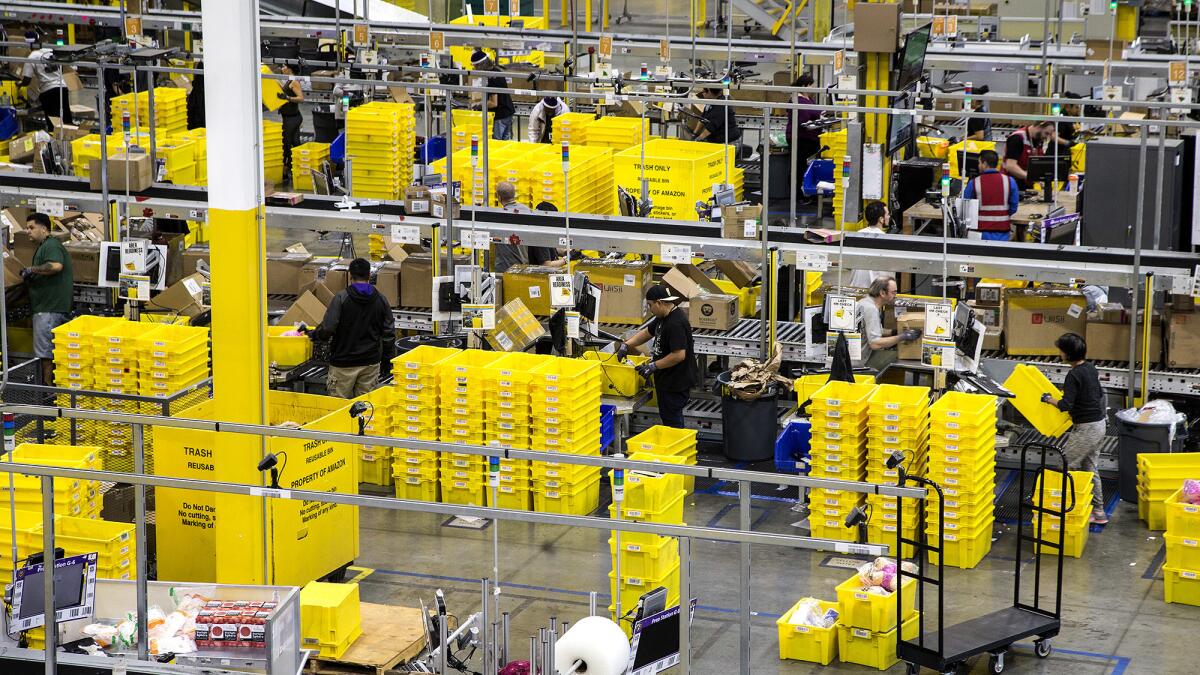In California’s Inland Empire, fewer than half of jobs pay a living wage

- Share via
At first glance, the economy of the Inland Empire looks rosy.
The vast area encompassing Riverside and San Bernardino counties has added 200,000 jobs since the peak of the recession. Payrolls are swelling at a year-over-year rate of 2.5%, faster than in neighboring Los Angeles County or California overall.
The jobless rate is down to 4.1%, and the spectacular growth of the warehouse and transportation industries seems unstoppable, fueled by the region’s e-commerce appetite along with the fact that, despite the current trade dispute with China, the port complex of Los Angeles and Long Beach remains the main hub of imports from across Asia.
But a report released Tuesday by UC Riverside’s new Center for Social Innovation, “State of Work in the Inland Empire,” paints a grim picture of the struggles behind the broad statistics.
“Our region has bounced back in terms of job creation,” said Karthick Ramakrishnan, the public policy and political science professor who founded the center this year. “But it shouldn’t be inevitable that we’re doomed to low-wage jobs, low benefits and contingent workers.”
The report, drawing on data from the U.S. Census Bureau, the U.S. Bureau of Labor Statistics and academic studies, found that:
- Despite lower housing costs in the Inland Empire than in coastal counties, just 4 in 10 jobs pay enough for families to make ends meet.
- Poverty rates in Riverside (15.3%) and San Bernardino (17.6%) were higher in 2016 than before the Great Recession, and income inequality grew from 2010 to 2016.
- 350,000 residents commute to jobs outside the region, mainly because of a shortage of well-paying opportunities.
- Just 151 out of every 1,000 high school freshmen go on to finish a four-year college degree.
“Compared to employees in the rest of Southern California and statewide, Inland Empire workers have higher rates of poverty and lower earnings, lower percentages with full-time, full-year employment, and lower percentages with employer-provided health insurance,” the report says.
To be sure, Inland Empire’s unemployment rate, which hit 14.4% at the depths of the downturn in July 2010, has plummeted. In Riverside, the number of jobs grew by 33% from 2010 to 2017. In San Bernardino, it grew by 29%. Statewide, the rise was 23%.
The report traces the economic history of the region, which bled manufacturing jobs as global competition took hold. Kaiser Steel in Fontana once employed more than 9,000 well-paid unionized workers at its steel mill and iron ore mine. Both shut down in 1983.
The closure of military bases also took a toll. Over just one two-year span, 1991 to 1993, 32,000 jobs were lost with the shuttering of Norton Air Base and Pomona’s guided missile factory and the downsizing of March Air Force Base.
“Without access to local jobs, a growing number of Inland residents began commuting to jobs in coastal counties,” the report says, “while increasing numbers of coastal workers moved inland for cheaper housing.”
This decade, two sectors have accounted for most of the region’s job growth.
More than 85,000 new jobs — a quarter of payroll expansion from 2010 to 2017 — are in healthcare. The surge is driven by the 2010 Affordable Care Act, which brought medical insurance to tens of thousands of Inland Empire residents, many of whom work for companies that don’t provide it.
Moreover, as the baby boom generation has aged, older residents are requiring more care, including by an expanding workforce of home healthcare workers paid through California’s Medi-Cal.
Loma Linda University is raising $366 million to build two hospitals: a 373-bed children’s facility and a 16-story adult hospital that will be the tallest building in San Bernardino County. A new UC Riverside School of Medicine graduated its first class in June 2017.
“With these projects, healthcare will grow middle-class jobs,” Ramakrishnan said.

The transportation and warehouse sector added 68,000 jobs over the same period, the second-largest number after healthcare’s. Amazon, with 13 massive warehouses, is now the region’s largest single employer, with about 18,000 workers.
Facing a labor shortage as unemployment dropped, the company last month raised its base wage to $15 an hour, while cutting workers’ bonuses and stock plans. But while $15 an hour is higher than the state’s current minimum wage — $11 an hour for large companies, rising to $12 on Jan. 1 — it fails to provide what economists call a “living wage” in the region, according to the report.
According to a widely used standard created by MIT to measure local living costs and wages, in an Inland Empire family of four with two working adults, each parent must earn about $18 an hour, or about $37,000 a year, to make ends meet. “Only 38% of jobs in the Inland Empire” pay $36,000 or more a year, the report says.
A case study in the report describes a family in which both parents are Teamsters at a Stater Bros. warehouse in San Bernardino. The mother makes $26 an hour, with a $13 hourly bonus in high productivity periods, along with health insurance, a pension, sick days and four weeks of paid vacation. By contrast, her daughter, who works at Amazon, earns far less with fewer benefits, the study says, and cannot afford Amazon’s health insurance, which would require premiums amounting to about half her full-time wages.
A fifth of all workers in the Riverside-San Bernardino-Ontario metropolitan area belong to unions. Union membership has grown by 26% over the last decade, even as statewide unionization has remained flat. But much of the growth has been among public employees in healthcare, social services and education. Teamsters Local 1932, with 14,500 public sector workers in the region, recently organized 500 early childhood education specialists at San Bernardino’s preschool division, raising their wages with a first contract this year.
No Amazon employees are unionized, and “nonunion workers are struggling to make ends meet,” said Ellen Reese, a sociology professor and coauthor of the report. “Workers, unions, community organizations and employers need to work together to improve conditions.”
“Improving earnings, benefits and job stability for workers in the Inland Empire would not only help reduce poverty, it would also increase consumer spending and local revenues, creating positive ripple effects for the regional economy,” the report concludes.
Twitter: @margotroosevelt
More to Read
Inside the business of entertainment
The Wide Shot brings you news, analysis and insights on everything from streaming wars to production — and what it all means for the future.
You may occasionally receive promotional content from the Los Angeles Times.











